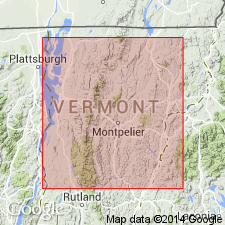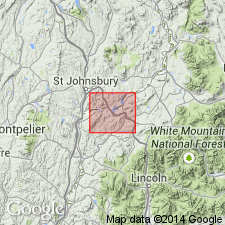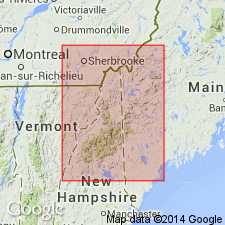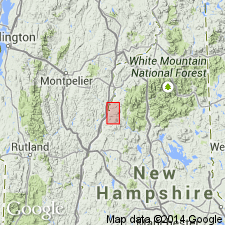
- Usage in publication:
-
- Fairlee granite gneiss
- Modifications:
-
- Original reference
- AAPG geologic province:
-
- New England province
Summary:
Table opp. p. 288. Fairlee granite gneiss. Listed this name in Cambrian of eastern Vermont, but without definition. Probably named for Fairlee Township, McCube quadrangle, Orange County, northeastern Vermont, or some of the geographic Fairlee features within that township.
Source: US geologic names lexicon (USGS Bull. 896, p. 714).

- Usage in publication:
-
- Fairlee quartz monzonite
- Modifications:
-
- Redescribed
- AAPG geologic province:
-
- New England province
Summary:
J.B. Hadley (letter dated April 23, 1936). In my opinion, and in opinion of M. Billings, the formation referred to, but not described, by Foyles and Richardson is quartz monzonite, and I am calling it Fairlee quartz monzonite in report in preparation.
Source: US geologic names lexicon (USGS Bull. 896, p. 714).

- Usage in publication:
-
- Fairlee quartz monzonite
- Modifications:
-
- Revised
- AAPG geologic province:
-
- New England province
Summary:
Pg. 499. Fairlee quartz monzonite. Belongs to Highlandcroft magma series. [Age is Late Ordovician.]
Source: Publication; US geologic names lexicon (USGS Bull. 1200, p. 1309-1310).

- Usage in publication:
-
- Fairlee quartz monzonite
- Modifications:
-
- Principal reference
- Dominant lithology:
-
- Quartz monzonite
- AAPG geologic province:
-
- New England province
Summary:
Pg. 22. Fairlee quartz monzonite. Described as coarse-grained, greenish-gray, quartz monzonite with local pink tinges. Generally appears more or less crushed and foliated; converted to phyllonite on margins of the body. Age designated probably Late Ordovician. Extends into New Hampshire. Type locality given.
Type locality: strikingly exposed on cliffs known as the Palisades in Fairlee, Orange Co., east-central VT. Forms several prominent hills in Mount Cube 15-min quadrangle in Bradford, VT, and Piermont, NH.
Source: US geologic names lexicon (USGS Bull. 1200, p. 1309-1310).

- Usage in publication:
-
- Fairlee Quartz Monzonite*
- Modifications:
-
- Geochronologic dating
- Revised
- AAPG geologic province:
-
- New England province
Summary:
Fairlee Quartz Monzonite included in Highlandcroft Plutonic Suite. Six of the suite's eight plutons were dated by U-Th-Pb methods. Age ranges from 453 to 443 Ma. Individual ages are (from north to south): Attean Quartz Monzonite, 443+/-4 Ma; Adamstown Granite, about 453 Ma; Highlandcroft Granodiorite, 450+/-5 Ma; these three dates support Naylor's (1969) conclusion that the Highlandcroft and Oliverian Plutonic Suites are coeval. The East Inlet pluton, located 20 km northwest of the Highlandcroft belt, yields a younger age of 430+/-4 Ma. Zircons from the Fairlee Quartz Monzonite and Lost Nation pluton (a quartz monzonite) yield scattered isotopic data; Fairlee is about 450 Ma and Lost Nation is about 440 Ma. Geologically, the Fairlee may be coeval with the East Inlet. On the basis of these ages, geologic constraints, and time-scale consideration, the age of the Highlandcroft Plutonic Suite magmatism ranges from Middle or Late Ordovician throughout at least the Early to Middle Silurian.
Source: GNU records (USGS DDS-6; Reston GNULEX).

- Usage in publication:
-
- Fairlee Quartz Monzonite*
- Modifications:
-
- Age modified
- Geochronologic dating
- Areal extent
- AAPG geologic province:
-
- New England province
Summary:
Composes the Fairlee pluton in Connecticut River valley west of Piermont, NH. Both Fairlee pluton and Mount Clough pluton (Bethlehem Gneiss) to the east have been dated at 410 +/-5 Ma by U-Pb zircon methods (Aleinikoff and Moench, 1987; Moench and Aleinikoff, 1987; reported ages later revised by J.N. Aleinikoff, 1989, oral commun.). Report includes geologic map. [Report indicates age as Devonian, but 410 +/-5 Ma would indicate a Silurian or Devonian(?) age according to available time charts. No explanation as to choice of Devonian here.]
Source: GNU records (USGS DDS-6; Reston GNULEX).
For more information, please contact Nancy Stamm, Geologic Names Committee Secretary.
Asterisk (*) indicates published by U.S. Geological Survey authors.
"No current usage" (†) implies that a name has been abandoned or has fallen into disuse. Former usage and, if known, replacement name given in parentheses ( ).
Slash (/) indicates name conflicts with nomenclatural guidelines (CSN, 1933; ACSN, 1961, 1970; NACSN, 1983, 2005, 2021). May be explained within brackets ([ ]).

